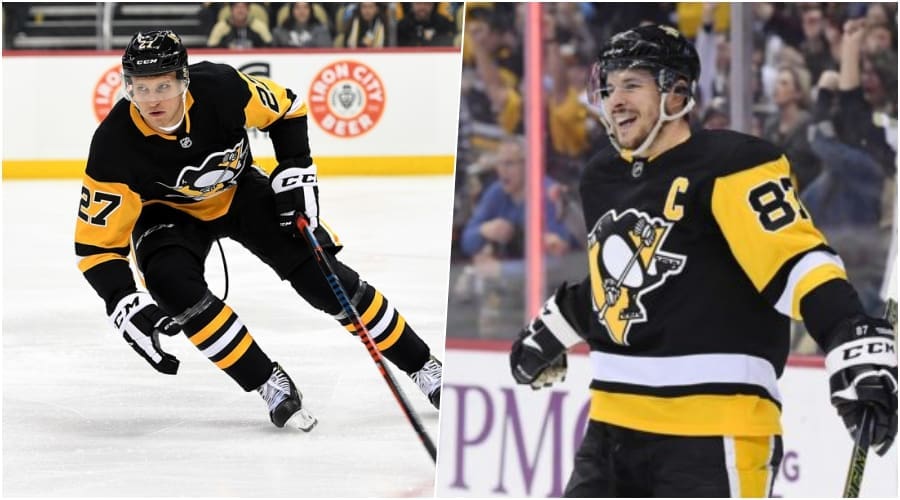Penguins
Penguins Itching to Try Bjugstad with Crosby; Creates New Hole at 3C?

Pittsburgh Penguins head coach Mike Sullivan said everything is on the table. Despite numerous questions over the past week about Nick Bjugstad being a winger or a center, the Penguins hierarchy including Sullivan and General Manager Jim Rutherford refused to cement Bjugstad as the third pivot.
Sullivan admitted the Penguins are discussing the possibility of putting Bjugstad on the right wing with Sidney Crosby when Evgeni Malkin returns from his hand injury, or sooner.
“It’s something we’ve discussed. He’s played more on the wing than he has at center in the last couple of years,” admitted Sullivan. “Although he is a natural center and has a comfort level playing there. WIth (Malkin) out, it makes it more difficult to make that decision, but that’s not to say we can’t.”
If not Bjugstad, who is the third line center? Wasn’t the point of the Derick Brassard trade to get a third line center who could work with Phil Kessel far better than Brassard?
Is anyone else confused?
“We’ve got enough center icemen in the lineup, we can try different things if we so choose,” Sullivan said before flatly admitting Bjugstad has attributes which could make him successful on Crosby’s right wing. “Yeah, he does. He’s got great offensive instincts. He can shoot the puck. He’s shown an ability to play in a top-six role.”
Reading between the lines of the repeated allusions to Bjugstad on the wing instead of at center and that admission, the team seems to be salivating at the chance to put the 6-foot-6, 218-pound, right-handed shot Bjugstad with Crosby and Jake Guentzel.
Center Jared McCann was also acquired with Bjugstad in the Brassard deal. McCann, 22, has been the Penguins third center as Bjugstad has anchored the second line, in Evgeni Malkin’s absence. McCann is in his fourth NHL season after being selected in the first round by the Vancouver Canucks (24th overall) and beginning his NHL career as an 18-year-old.
The book on McCann, as confirmed by Rutherford, is he is a defensive center. He was Florida’s fourth line center and set a career-best 28 points (9g, 19a) last season.
If this the Penguins plan, Phil Kessel probably won’t be a happy camper.
McCann has not put up positive analytics either. His Corsi, scoring chance ratio, and high-danger scoring chance ratios are all in the negative for this season, and most of his career. His scoring chance ratios are especially troubling, at least in terms of a third line center who would be asked for an offensive contribution for a Stanley Cup hopeful.
This season, McCann’s scoring chance ratio is 47 percent. Last season it was 48 percent. McCann would be a fine fourth line center, but a third liner responsible for playing with Phil Kessel is a tall task.
Is Teddy Blueger in line for a shot? He’s a sparkplug who plays a very different game than anything Kessel has played with before. Could Kessel keep up, or even want to keep up with Blueger?
Or maybe the Penguins are about to adopt the strategy which they used successfully in the middle of last season until they acquired Brassard. In January and part of February, the Penguins often double-shifted one of Crosby or Malkin. Sometimes both. And the third line center–then Riley Sheahan–became a placeholder responsible for defensive zone starts.
That strategy was again used Tuesday night against Carolina after the Penguins trailed and the middle lines did not produce anything. The Penguins second line with Kessel and Bjugstad did not produce a high-danger scoring chance and generated just three total scoring chances.
It wasn’t Kessel’s finest effort.
The third line with McCann was soon taken over by Crosby who generated chances with Dominik Simon and Patric Hornqvist. In the final tally, the Penguins out-chanced Carolina, 21-17. Crosby factored into 12 of those chances and six of the Penguins eight high-danger chances.
So, maybe the Penguins will simply stack their top-six, and rotate their top centers through the third line as a strategy. It works because the Penguins are deep at wing and the move gets the Penguins stars away from top pairing defensemen.
But it can also wear down the Penguins top centers before they get to the Stanley Cup finish line.












